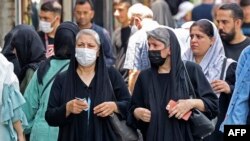Welcome back to The Farda Briefing, an RFE/RL newsletter that tracks the key issues in Iran and explains why they matter.
I'm Mehrdad Mirdamadi, a senior editor and journalist at RFE/RL's Radio Farda. Here's what I've been following and what I'm watching out for in the days ahead.
The Big Issue
A new crackdown by Iranian authorities on women who violate the country’s “hijab and chastity" law has been widely criticized, even by figures within the clerical establishment.
Iran’s notorious morality police have become increasingly violent in enforcing the mandatory hijab. In response, women have become increasingly defiant.
Abdolhadi Mar'ashi, an influential cleric in the holy city of Mashhad, resigned from his provincial post to protest the misconduct of the Guidance Patrols, or morality police. In his resignation letter, Mar'ashi said “our understanding of what is right and what is wrong under Islam has been limited only to the hijab.”
Instead of fixating on the enforcement of the hijab law, Mar'ashi suggested that authorities should prioritize other key issues like “government corruption, social justice, economic security, class disparity, drug addiction, national poverty, [and] freedom of expression.”
Jalal Rashidi Koochi, a lawmaker who is the head of a parliamentary committee for domestic affairs, said the morality police “haven’t made anyone observe the hijab,” suggesting the use of force had backfired.
Why It Matters: The new enforcement of the hijab law has exposed divisions in the Islamic republic, pitting citizens against supporters of the clerical regime. Confrontations have occurred in the streets of many cities in Iran.
Significantly for the establishment, the hijab issue has revealed splits among the clergy, its main support base. More criticism from senior religious figures will mean more defiance on the streets.
With many Iranians already hit by record inflation and rising unemployment, the government’s handling of the hijab issue has given citizens another reason to show their discontent.
What's Next: The authorities have used force, imprisonment, and intimidation to enforce the hijab law. Even so, the public has remained defiant, as has been the case for the past 40 years. This defiance is set to continue even if the authorities continue or double down on their enforcement of the hijab law, which requires women and girls over the age of 9 to wear a head scarf in public. If the establishment does not soften its stance, there is likely to be more street protests and acts of social disobedience.
Stories You Might Have Missed
• Iran's Ministry of Guidance has told advertising agencies that women are now prohibited from appearing in advertisements. The ministry sent a letter to the agencies over the weekend following the release of a promotional video by the Domino ice cream company that featured a female actress wearing a sweater who continues to put on further layers of clothing while images of an ice cream bar flash across the screen. At the end of the ad, the actress is wearing a parka and winter hat while taking a bite of the ice cream bar.
A government agency subsequently called the ad "a crime" and condemned the use of a female actress saying such ads lead to the "promotion of immorality" in the society.
• Relatives of Nazanin Bahrami say the Iranian actress has been arrested by undercover police in central Tehran. Bahrami was one of some 800 women to recently sign a statement denouncing the “systematic” sexual harassment and violence against women in the Iranian film industry and had called for a mechanism to ensure those responsible were dealt with.
Her relatives said Bahrami was returning home in the capital from work when she was surrounded by plainclothes police and taken into custody. Her whereabouts are not known, and officials have not commented on the situation.
What We're Watching
During Russian President Vladimir Putin’s visit to Iran last week, Supreme Leader Ayatollah Ali Khamenei explicitly backed Moscow’s unprovoked invasion of Ukraine. Since then, Iranian state media have championed Russian policies and defended Moscow’s aggression in Europe, in a sign of deepening ties between Tehran and Moscow.
Since then-U.S. President Donald Trump withdrew Washington from the Iran nuclear deal and reimposed sanctions in 2018, Tehran has followed a policy of "looking to the East," turning to allies Russia and China. In comments that raised eyebrows, Iranian lawmaker Hosein Jalali said “China’s possible invasion of Taiwan” would be “a source of pride for the Islamic republic." Jalali also said Russia’s invasion of Ukraine has offered Tehran a “real opportunity” to become “closer” to Moscow.
Why It Matters: Khamenei’s strong backing for Putin and Moscow’s invasion has provoked widespread criticism. Former government officials have accused Khamenei of overturning one of the key tenets of Iran’s foreign policy since the Islamic Revolution: “Neither East, nor West, but the Islamic Republic.”
Some Iranian social media users have complained that the country has become a “Russian colony.” Many Iranians distrust Russia and have been critical of Moscow’s war in Ukraine.
That's all from me for now. Don't forget to send me any questions, comments, or tips that you have.
If you enjoyed this briefing and don't want to miss the next edition, subscribe here. It will be sent to your in-box every Wednesday.
Until next time,
Mehrdad Mirdamadi





